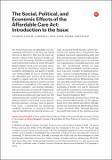| dc.contributor.author | Campbell, AL | |
| dc.contributor.author | Shore-Sheppard, L | |
| dc.date.accessioned | 2021-11-12T16:23:36Z | |
| dc.date.available | 2021-11-12T16:23:36Z | |
| dc.date.issued | 2020-07-01 | |
| dc.identifier.uri | https://hdl.handle.net/1721.1/138126 | |
| dc.description.abstract | The Patient Protection and Affordable Care Act, commonly referred to as the ACA and signed into law on March 23, 2010, was the most significant reform of the American health-care system since the passage of Medicare and Medicaid a half century earlier. As former President Barack Obama noted in his personal assessment, the law was intended to “improve the accessibility, affordability, and quality of health care” (Obama 2016). In service of these goals, the “affordable care” portion of the measure sought to expand coverage to the uninsured through Medicaid expansion and the creation of insurance marketplaces with sliding-scale premium subsidies, cost-sharing subsidies, and rate restrictions, as well as the requirement that dependents be permitted to remain on parental insurance plans up to age twenty-six. The “patient protection” portion included new regulations aimed at increasing access and improving insurance coverage, such as guaranteed issue, a prohibition on preexisting condition exclusions, no annual or lifetime caps on expenditures for covered services, coverage of essential health benefits, and free preventive care, among others. This portion also included provisions implementing pilot and demonstration projects aimed at exploring new payment and care models such as accountable care organizations or bundled payments, and new care coordination models for dual Medicare-Medicaid eligibles and other populations. Last were a number of additional provisions—such as increased funding for community health centers and incentives for states to continue rebalancing their Medicaid long-term care spending toward home- and community-based services—also intended to improve the availability of health care and its alignment with need (for summaries of ACA provisions, see American Public Health Association 2012; Kaiser Family Foundation 2013). | en_US |
| dc.language.iso | en | |
| dc.publisher | Russell Sage Foundation | en_US |
| dc.relation.isversionof | 10.7758/rsf.2020.6.2.01 | en_US |
| dc.rights | Creative Commons Attribution-NonCommercial-NoDerivs License | en_US |
| dc.rights.uri | http://creativecommons.org/licenses/by-nc-nd/3.0/ | en_US |
| dc.source | Russell Sage Foundation Journal of the Social Sciences | en_US |
| dc.title | The social, political, and economic effects of the affordable care act: Introduction to the issue | en_US |
| dc.type | Article | en_US |
| dc.identifier.citation | Campbell, AL and Shore-Sheppard, L. 2020. "The social, political, and economic effects of the affordable care act: Introduction to the issue." RSF, 6 (2). | |
| dc.contributor.department | Massachusetts Institute of Technology. Department of Political Science | |
| dc.relation.journal | RSF | en_US |
| dc.eprint.version | Final published version | en_US |
| dc.type.uri | http://purl.org/eprint/type/JournalArticle | en_US |
| eprint.status | http://purl.org/eprint/status/PeerReviewed | en_US |
| dc.date.updated | 2021-11-12T16:17:33Z | |
| dspace.orderedauthors | Campbell, AL; Shore-Sheppard, L | en_US |
| dspace.date.submission | 2021-11-12T16:17:34Z | |
| mit.journal.volume | 6 | en_US |
| mit.journal.issue | 2 | en_US |
| mit.license | PUBLISHER_CC | |
| mit.metadata.status | Authority Work and Publication Information Needed | en_US |
